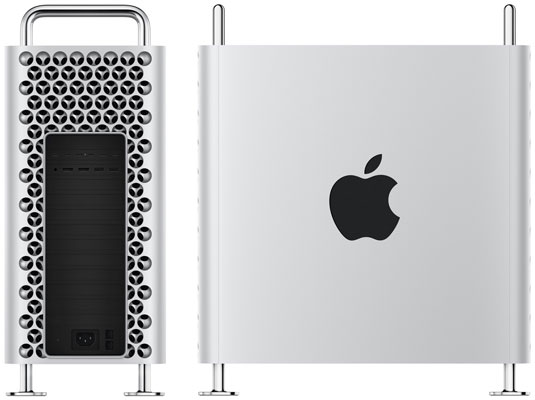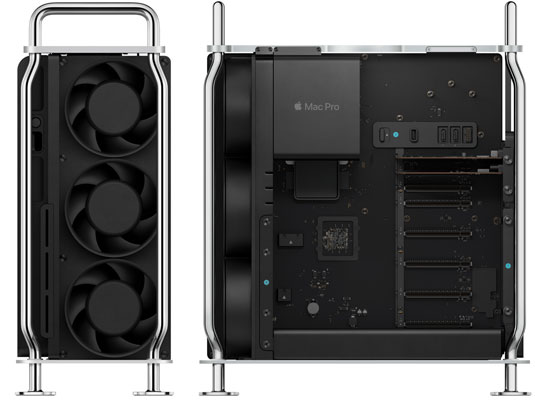Hosted by site sponsor WebMate.
Apple Silicon Mac Pro Tower Q&A
Published July 28, 2023
All Mac Q&As >> Apple Silicon Mac Pro Tower (Home)
To be notified of new Q&As, sign up for EveryMac.com's bimonthly email list.
What are all the differences between the Mac Pro "M2 Ultra" (2023) models? Which is best for me?
For all practical purposes, each Mac Pro "M2 Ultra" (2023) model is a configure-to-order system.
However, because they differ in terms of technical specs, identifiers, and price, EveryMac.com documents the primary tower models as the Mac Pro "M2 Ultra" 24 CPU/60 GPU and Mac Pro "M2 Ultra" 24 CPU/76 GPU and the rack-mount models as the Mac Pro "M2 Ultra" 24 CPU/60 GPU (Rack) and Mac Pro "M2 Ultra" 24 CPU/76 GPU (Rack).
The configuration options are well worth evaluating to find the best selections for you. There are a large number of similarities among these models that are important to understand, too.

Photo Credit: Apple, Inc. (2023 Mac Pro Tower)
External & Connectivity Similarities
The "2023" Mac Pro models share large, expandable "cheese grater" silver colored aluminum cases.
The tower and rack-mount "2023" Mac Pro models all have the same substantial connectivity, including eight Thunderbolt 4 ports (up to 40 Gb/s) -- two on the top or front and six on the back -- as well as two HDMI ports, two USB-A ports (up to 5 Gb/s), and two 10Gb Ethernet ports and a 3.5 mm headphone jack all on the back. All models have the same 802.11ax Wi-Fi 6E, and Bluetooth 5.3, also.

Photo Credit: Apple, Inc. (2023 Mac Pro: Back/Side View)
Identification Differences
As diligently hand documented by EveryMac.com, the "2023" Mac Pro models share the same Model Identifiers in software, but have different Model Numbers and EMC Numbers on the hardware itself:
| 2023 Mac Pro | Model No. | EMC No. | Model ID |
| Tower | A2786 | 8163 | Mac14,8 |
| Rack | A2787 | 8164 | Mac14,8 |
To locate the model identifier, select "About This Mac" under the Apple Menu on the computer, click the "More Info..." button, and click the "System Report" button. The model number and EMC number are on the underside.
EveryMac.com's Ultimate Mac Lookup feature also can pinpoint these models by other identifiers, as well.
More details about specific identifiers are provided in EveryMac.com's exhaustive Mac Identification section.
Internal Similarities & Differences
Internally, the layout of each "2023" Mac Pro model is the same.

Photo Credit: Apple, Inc. (2023 Mac Pro: Inside with Cover Removed)
All of these models have the same SoC design -- which integrate the CPU, GPU, and RAM -- that cannot be upgraded after the initial system purchase, as well as the same removable SSD modules and seven PCIe expansion slots (which support a variety of PCIe cards, including SSD storage options, but not video cards).
macOS Support Similarities
All of the "2023" Mac Pro models originally shipped with macOS Ventura macOS 13.4 (22F2073). Both tower and rack-mountable models have the same operating system support, too.
So, which specific configuration options are best for me?
The "2023" Mac Pro models can be customized in terms of case type, graphics processor, memory, storage, and feet.
Many of these decisions depend on your needs and budget, but EveryMac.com can help you evaluate the value of each option to make the best decision for you.
Case Type
The first decision is to determine whether or not you need a standard tower case or the rack-mountable option. The rack-mount case is an extra US$500, so unless you need the Mac Pro to operate in a rack -- which generally is reserved for servers -- you should stick with the standard tower option.
CPU/GPU (No Upgrades Later)
The "2023" Mac Pro is configured by default with a 24-Core M2 Ultra CPU and 60-Core GPU. The CPU cannot be upgraded at all, at the time of purchase or later, but the GPU can be configured with 72-Cores for an extra US$1000.
Because the GPU cannot be upgraded later, if you perform high-end graphics or video work, this upgrade represents 20% more cores for 15% more money and could be a worthwhile upgrade when used with high-end software.
Memory (No Upgrades Later)
By default, the "2023" Mac Pro is equipped with 64 GB of RAM, but it can be configured with 128 GB or 192 GB of RAM at the time of initial system purchase for an additional US$800 or US$1600, respectively.
Because the RAM cannot be upgraded later, more RAM will not only increase performance but also likely will prolong the usable life of the computer. 64 GB of RAM is pretty paltry for a professional desktop system these days. In terms of value, the 128 GB option likely is the sweet spot. 192 GB of RAM is twice the price of 128 GB, but it isn't twice the RAM.
Storage (Less Expensive Third Party PCIe Options Available)
The "2023" Mac Pro models are equipped by default with a 1 TB SSD. At the time of system purchase, these models can be configured with 2 TB of SSD storage for an extra US$400, 4 TB of SSD storage for an extra US$1000, or 8 TB of SSD storage for an extra US$2200.
The internal storage in the "2023" Mac Pro models actually can be upgraded, but Apple charges a US$600 premium to these initial installation amounts for its proprietary upgrade kits to perform the upgrade yourself later.
Because it is straightforward and less expensive to add more storage later via PCIe slots, storage is the easiest budget item to cut from an initial purchase.
Feet (Buy Third-Party Wheels Later if Needed)
For US$400, the "2023" Mac Pro can be custom configured with wheels instead of the standard feet. More affordable third-party options are available for purchase later, so there is little need to buy Apple's wheels.
It is hoped that these Mac Pro details will help you make the best choices for your specific needs and budget. If you do not need the extra expansion provided by the Mac Pro -- support for internal storage upgrades, PCIe slots, and more ports -- you might prefer the less expensive Mac Studio.
Site sponsor Adorama has new Mac Pro and Mac Studio models with free shipping for all.
Permalink | Report an Error/Typo | Sign Up for Site Update Notices
<< Apple Silicon Mac Pro (2023+) Q&A (Main) | All Mac Q&As
Established in 1996, EveryMac.com has been created by experts with decades of experience with Apple hardware. EveryMac.com includes, and always has included, original research incorporating detailed, hands-on inspection of packaging, computers, and devices as well as extensive real-world use. All information is provided in good faith, but no website or person is perfect. Accordingly, EveryMac.com is provided "as is" without warranty of any kind whatsoever. EveryMac.com, and the authors thereof, shall not be held responsible or liable, under any circumstances, for any damages resulting from the use or inability to use the information within. For complete disclaimer and copyright information please read and understand the Terms of Use and the Privacy Policy before using EveryMac.com. Copying, scraping, or use of any content without expressed permission is not allowed, although links to any page are welcomed and appreciated.
